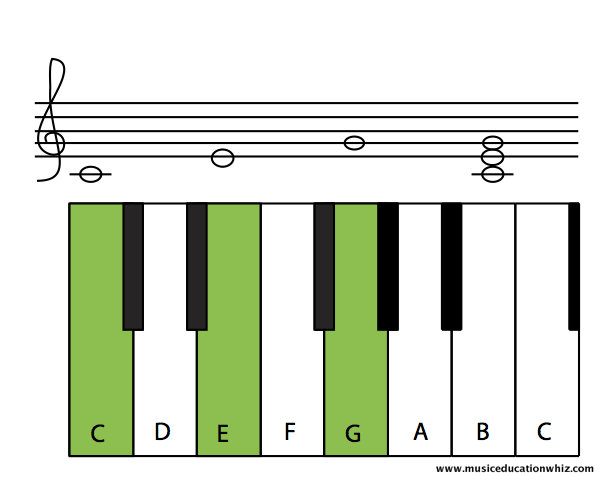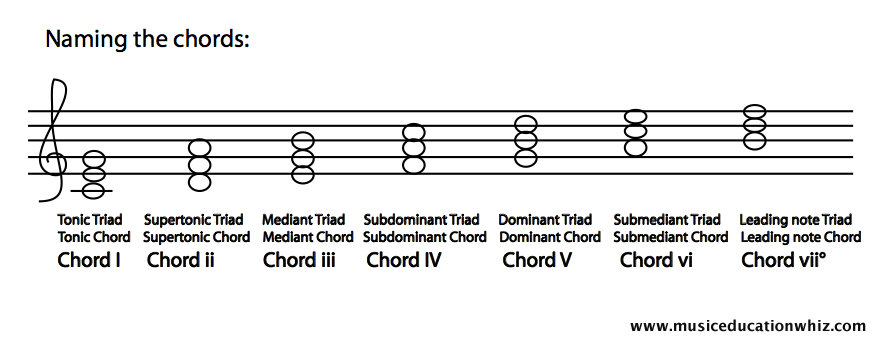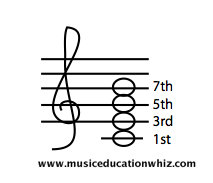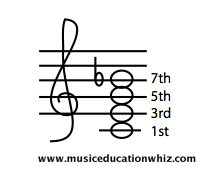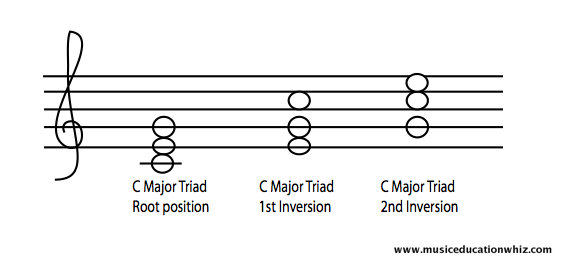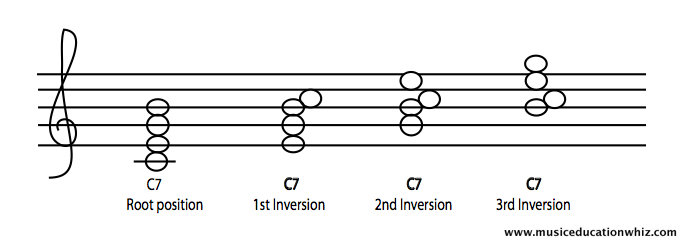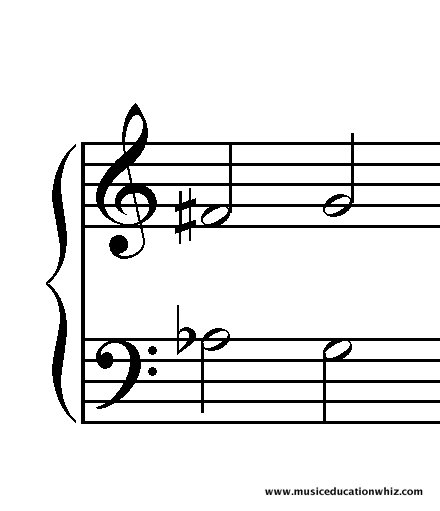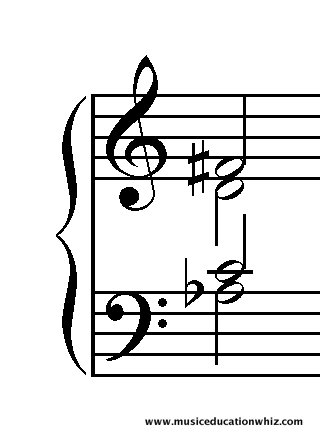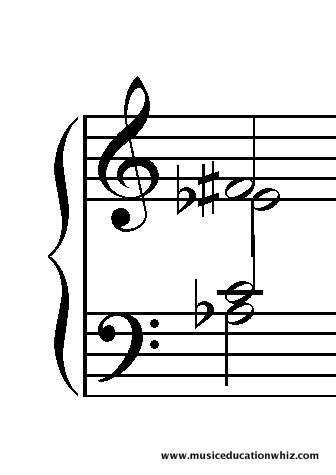Back to andrewdownes.com

Music Education
Resources by Paula Downes, a lot of music by Andrew Downes
Chords Explained
On this page:
Triads
Major, Minor, Augmented and Diminished Triads
7ths
Inversions
Decorating with inessential notes
Figured Bass
Cycle of 5ths
Cadences
Diminished 7th
Neapolitan 6th
Augmented 6th
Triads
Triads are three-note chords, which are formed when
you play a note, miss a note, play a note, miss a note, play a note.
For example, play C, miss out D, play E, miss out F, play G. You now have a C major triad. C is the 1st note or the root of the triad, E is the 3rd note and G is the 5th note.
Now watch the video to hear this triad:
We can form triads on each note of a scale: (click to review scales)
Now watch the video to hear these triads:
We call each triad the same name as the scale
degree it is formed above:
Major, Minor, Augmented and Diminished triads
You may need to review intervals in order to understand this section.
A triad is major if the interval between the 1st and the 3rd note
of the triad is a major 3rd, and the interval between the 3rd and
the 5th note is a minor 3rd. See the example below.
A triad is minor if the interval between the 1st
and the 3rd note of the triad is a minor 3rd, and the interval between the 3rd
and the 5th note is a major 3rd. See the example below.
Now listen to these triads on the video:

A triad is augmented if the interval between the
1st and the 3rd note of the triad is a major 3rd, and the interval
between the 3rd and the 5th note is also a major 3rd. See the example below.
A triad is diminished if the interval between
the 1st and the 3rd note of the triad is a minor 3rd, and the
interval between the 3rd and the 5th note is also a minor
3rd. See the example below.
Now listen to these triads on the video:
If a triad is major, we use uppercase Roman
Numerals; if a triad is minor, we use lower case Roman Numerals. If a triad is
diminished, we use lower case Roman Numerals and a little circle next to it: ° If a
triad is augmented we use upper case Roman Numerals and a little plus sign next
to it:+ See the 'Naming the chords' image above to see which triads in a major key are major, minor or diminished.
In a major key, chords I, IV and V are all
major; ii, iii, and vi are minor; and vii° is
diminished. Listen to the chords of the C major scale in the following video:
In a minor key it depends on whether we are dealing
with melodic, harmonic or natural minor scales.
Natural Minor and Melodic Minor Descending:
Chords I, iv and v are minor; ii° is diminished; III, VI and VII are major. Watch the video to see and hear these triads.
Melodic Minor Ascending:
Chords i and ii are minor; III+ is augmented; IV and V are major, vi° and vii°
are diminished. Watch the video to see and hear these triads.
Harmonic Minor:
Chords i and iv are minor; ii° and vii°
are diminished; III+ is augmented; V and VI are major. Watch the video to see and hear these triads.
7th Chords
A chord containing the 1st, 3rd,
5th and 7th notes above a note is called a 7th
chord:
This chord is called:

We can add a flat before the 7th to show that that note is flattened:

Watch the video to see and hear these examples:
The dominant 7th, chord V7 is the most common type of 7th chord. It is a 7th chord on the dominant scale degree and has a strong drive towards chord I. This is due to the voice-leading in this progression: the horizontal movement of individual notes in one chord to another note in the next chord. The 7th of V7 wants to fall to the 3rd of chord I; the 5th of V7 wants to fall to the tonic; the 3rd of V7 (the leading note) wants to rise to the tonic; the root of V7 strongly rises or falls to the tonic. Watch the video to see and hear this chord progression. Notice that I have arranged the notes of the tonic triad differently from above. This is simply to make it sound better. Different arrangements of notes in a chord will be discussed below.
Inversions
The chords above are all in root position. This means the root is in the bass/at the bottom. Any
other note of a chord can be in the bass.
This means the chord has been inverted: if the 3rd is in the bass, the
chord is in 1st inversion; if the 5th is in the bass, the
chord is in 2nd inversion.
Watch the video to see and hear these examples:
7th chords can also have the 7th in the bass. This would be in 3rd inversion:
Watch the video to see and hear these examples:
When a note other than the root is in the bass, the notes above it can be in any order. The note in the bass is the factor that determines the inversion, nothing else.
We use letters to label inversions as follows:
Ia = Tonic triad in root position
Ib = Tonic triad in 1st inversion
Ic = Tonic triad in 2nd inversion
I7d = Tonic 7th in 3rd inversion
Decorating chords with inessential notes
A
passing note does not belong to a chord. It fills in the gap between two notes in the
same part a third apart. See examples labelled 'p' below.
Passing notes turn disjunct
motion into smooth, conjunct motion.
Alternating harmony and passing notes can be
continued over several beats, providing nice scale passages, straight or
meandering.
Passing notes can be accented or unaccented. See examples of accented passing notes below ('ap')
An
auxiliary note does not belong to a chord. It links two statements of the
same note in the same part with a note a step above (upper auxiliary) or below (lower auxiliary) that note. See examples labelled 'a' below.
Auxilliary notes turn repeated notes into
conjunct motion, making them more musical.
Passing and auxiliary notes must always be approached by step, otherwise it sounds wrong.
When passing and/or auxiliary notes happen in two voices at once, they should be consonant with each other. Parallel thirds and sixths sound lovely. See the parallel 6ths in example below between the alto and bass parts, underlined in purple.
Arpeggiations
You can leap from a note in the chord to
another note in the chord in any part and then leap to a note in the next
chord. See examples labelled 'arp' below.
This example is the opening of Bach's Chorale Harmonisation of O Gott, du frommer Gott:
Now listen and watch this on the video below:
An anticipation note is a note that occurs in advance of the rest of the chord. This often happens at cadences. Watch the video to see and hear an example:
Suspensions
A suspension is a note that is prepared (present) in the chord before, and suspended over into the next chord, creating a dissonance, which must be resolved by falling by step.
A 4-3 suspension means that there is a note a 4th above the bass, which was present in the chord before. A 4th above the bass was considered to be a dissonance in the Baroque period, so had to be resolved by falling to the 3rd of the chord.
A 7-6 suspension means that there is a note a 7th above the bass, which was present in the chord before. A 7th above the bass was considered to be a dissonance in the Baroque period, so had to be resolved by falling to the 6th of the chord.
A 9-8 suspension means that there is a note a 9th above the bass, which was present in the chord before. A 9th above the bass was considered to be a dissonance in the Baroque period, so had to be resolved by falling to the 8th of the chord. Watch the video examples of all three types of suspension.
Figured
Bass
In the Baroque Period, continuo keyboard players
were given a bass line with figures. The
figures told them which chords to play above the bass line and in which inversion. They were required to improvise around these
chords.
The figures told them the
intervals to play above the bass notes.
5
3 means play a 3rd above the
bass note and play a 5th above the bass note. This creates a triad in root position.
It was faster, however, for players to just know what kind of chord the figures were referring to, rather than working out each note above the bass note:
|
Description |
Symbol |
Shortened version |
|
Triad in root position |
5 |
5, 3 or nothing |
|
Triad in 1st inversion |
6 |
6 |
|
Triad in 2nd inversion |
6 | |
|
7th chord in root position |
7 |
7 |
|
7th chord in 1st inversion |
6 |
6 |
|
7th chord in 2nd inversion |
6 | |
|
7th chord in 3rd inversion |
6 |
Sharps, flats and naturals were added before the numbers to indicate when a note should be chromatically altered. For a triad in root position, you would sometimes only see the accidental, meaning the 3rd of the chord is to be altered.
You will see examples of figured bass labelling in the Cycle of 5ths video below.
Suspensions would be shown with the number of the suspended note, followed by a dash, then its resolution:
4-3
7-6
9-8
Cycle of 5ths
This is a chord progression which is often used to modulate. It is called the cycle of 5ths, because each chord is a 5th higher than the one before. Each chord essentially becomes the dominant of the next chord, which is the reason why it is so useful for modulation. If all the chords are in root position, the bass line alternates between ascending a 4th and descending a 5th. 7ths can be added to alternate chords or to all the chords. Accidentals can be added to modulate to a particular key. The chords don't have to be in root position. Watch the video to see and hear the various possibilities of the cycle of 5ths:
Cadences
A cadence is the ‘punctuation’ of a musical phrase. The last two chords of the phrase form a cadence, and will either make the phrase sound 'finished'; 'unfinished'/like a question; or 'interrupted'. There are two or three names for some of the cadences below. The first name in each case is for the UK, the others are for the USA.
Perfect/Authentic/Full Close cadence: V (or V7) - I.
It sounds 'finished'.
Plagal cadence: IV - I.
It also sounds 'finished' but is not as strong as a perfect cadence. It is often used for the 'Amen' at the end of hymns.
Imperfect/Half/Half Close cadence: any chord - V
It sounds unfinished: something else needs to happen.
Interrupted/Deceptive cadence: V - vi (major key) or V - VI (minor key)
Watch and listen to these cadences in the video below:
More complex chords
Diminished 7th
This is a series of minor 3rds piled on top of each other. It is a useful chord for modulating to distant keys. It is often used in horror film music:
Neapolitan 6th
A Neapolitan 6th is a major triad in 1st inversion based on the flattened supertonic of the key. It is most often used in minor keys. It is called a '6th' because it is usually in 1st inversion so the name is based on the intervals of the notes in the chord above the bass note. It is often used at cadences in the following progressions:
bIIb - V - I (The characteristic interval of a diminished 3rd from the flattened supertonic in N6 to the 3rd of V will help you to identify the Neapolitan 6th chord)
bIIb - Ic - V - I (only in minor keys)
Watch and listen to these chord progressions on the video:
Augmented 6th
An Augmented 6th is a chord based on the flattened 6th scale degree containing the note an augmented 6th above that bass note. These outer notes usually resolve outwards in contrary motion to form an octave in the next chord, chord V:
There are three different types of Augmented 6th Chord:
The Italian 6th contains the flattened 6th scale degree, the major 3rd above that, and the augmented 6th above.
The Italian 6th leads into chord V as you can see and hear on the video below.
The French 6th contains the flattened 6th scale degree, the major 3rd above, the augmented 4th above, and the augmented 6th above. These notes are all part of the whole tone scale - a feature of French Impressionistic music:
The French 6th leads into chord V as you can see and hear on the video below.
The German 6th contains the flattened 6th scale degree, the major 3rd above, the perfect 5th above, and the augmented 6th above:
It sounds the same as a dominant 7th, but is spelt differently. (The F sharp would be a G flat in a dominant 7th). A dominant 7th would move to chord I or chord vi. The German 6th doesn't usually go straight to chord V as an Italian or French 6th would because parallel 5ths occur. Instead, it goes to Ic and then V; or the 5th above the flattened 6th scale degree moves to either the 3rd above (to create an Italian 6th) or the augmented 4th above (to create a French 6th)
Watch and hear all of the above examples on the video:
Home>Music Theory>Chords

Music Education
Resources by Paula Downes, a lot of music by Andrew Downes
Back to andrewdownes.com
Follow Cynthia Downes on Instagram to keep up-to-date with her blog posts.
If you have performed in any of Andrew Downes' works or come to listen, please share your experiences in the Premieres Blog! Also see what others have said. Thank you so much for your contribution.
